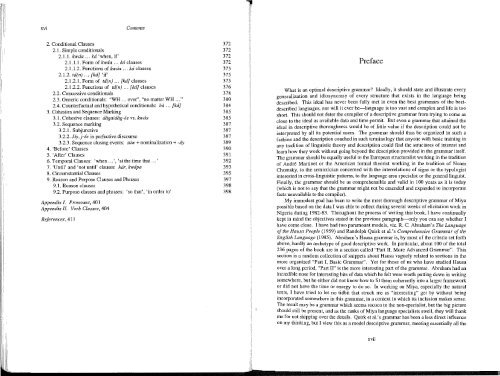A Grammar of Miya - UCLA Department of Linguistics
A Grammar of Miya - UCLA Department of Linguistics
A Grammar of Miya - UCLA Department of Linguistics
Create successful ePaper yourself
Turn your PDF publications into a flip-book with our unique Google optimized e-Paper software.
xvi Contents<br />
2. Conditional Clauses<br />
2.1. Simple conditionals<br />
2.1.1. kwda ... kd 'when, if'<br />
2.1.1.1. Form <strong>of</strong> kwda ... kd clauses<br />
2.1. I .2. Functions <strong>of</strong> kwda ... kd clauses<br />
2.1.2. td(n) ... [kd] 'if'<br />
2.1.2.1. Form <strong>of</strong> td(n) ... [kd] clauses<br />
2.1.2.2. Functions <strong>of</strong> td(n) ... [kd] clauses<br />
2.2. Concessive conditionals<br />
2.3. Generic conditionals: "WH ... ever", "no matter WH ... "<br />
2.4. Counterfactual and hypothetical conditionals: hi; ... [kd]<br />
3. Cohesion and Sequence Marking<br />
3.1. Cohesive clauses: daga/dag-ee vs. kwda<br />
3.2. Sequence marking<br />
3.2.1. Subjunctive<br />
3.2.2. fiy,j-ee in perfective discourse<br />
3.2.3. Sequence closing events: suw + nominalization + -dy<br />
4. 'Before' Clauses<br />
5. 'After' Clauses<br />
6. Temporal Clauses: 'when .. .', 'at the time that .. .'<br />
7. 'Until' and 'not until' clauses: hdr, kwdpa<br />
8. Circumstantial Clauses<br />
9. Reason and Purpose Clauses and Phrases<br />
9.1. Reason clauses<br />
9.2. Purpose clauses and phrases: 'so that', 'in order to'<br />
Appendix l. Pronouns, 401<br />
Appendix II. Verb Classes, 404<br />
References, 411<br />
372<br />
372<br />
372<br />
372<br />
373<br />
375<br />
375<br />
376<br />
378<br />
380<br />
384<br />
385<br />
385<br />
387<br />
387<br />
387<br />
389<br />
390<br />
391<br />
392<br />
393<br />
395<br />
397<br />
398<br />
398<br />
Preface<br />
What is an optimal descriptive grammar? Ideally, it should state and illustrate every<br />
generalization and idiosyncrasy <strong>of</strong> every structure that exists in the language being<br />
described. This ideal has never been fully met m even the best grammars <strong>of</strong> the bestdescribed<br />
languages, nor will it ever be-language is too vast and complex and life is too<br />
short. This should not deter the compiler <strong>of</strong> a descriptive grammar from trying to come as<br />
close to the ideal as available data and time permit. But even a grammar that attained the<br />
ideal in descriptive thoroughness would be <strong>of</strong> little value if the description could not be<br />
interpreted by all its potential users. The grammar should thus be organized in such a<br />
fashion and the description couched in such terminology that anyone with basic training in<br />
any tradition <strong>of</strong> linguistic theory and description could find the structures <strong>of</strong> interest and<br />
learn how they work without going beyond the description provided in the grammar itself.<br />
The grammar should be equally useful to the European structuralist working in the tradition<br />
<strong>of</strong> Andre Martinet or the American formal theorist working in the tradition <strong>of</strong> Noam<br />
Chomsky, to the semiotician concerned with the interrelations <strong>of</strong> signs or the typologist<br />
interested in cross-linguistic patterns, to the language area specialist or the general linguist.<br />
Finally, the grammar should be as comprehensible and valid in 100 years as it is today<br />
(which is not to say that the grammar might not be emended and expanded to incorporate<br />
facts unavailable to the compiler).<br />
My immodest goal has been to write the most thorough descriptive grammar <strong>of</strong> <strong>Miya</strong><br />
possible based on the data I was able to collect during several weeks <strong>of</strong> elicitation work in<br />
Nigeria during 1982-83. Throughout the process <strong>of</strong> writing this book, I have continually<br />
kept in mind the objectives stated in the previous paragraph-only you can say whether I<br />
have come close. I have had two paramount models, viz. R. C. Abraham's The Language<br />
<strong>of</strong> the Hausa People (1959) and Randolph Quirk et a1.' s Comprehensive <strong>Grammar</strong> <strong>of</strong> the<br />
English Language (1985). Abraham's Hausa grammar is, by most <strong>of</strong> the criteria set forth<br />
above, hardly an archetype <strong>of</strong> good descriptive work. In particular, about 100 <strong>of</strong> the total<br />
236 pages <strong>of</strong> the book are in a section called "Part II, More Advanced <strong>Grammar</strong>". This<br />
section is a random collection <strong>of</strong> snippets about Hausa vaguely related to sections in the<br />
more organized "Part I, Basic <strong>Grammar</strong>". Yet for those <strong>of</strong> us who have studied Hausa<br />
over a long period, "Part II" is the more interesting part <strong>of</strong> the grammar. Abraham had an<br />
incredible nose for interesting bits <strong>of</strong> data which he felt were worth putting down in writing<br />
somewhere, but he either did not know how to fit them coherently into a larger framework<br />
or did not have the time or energy to do so. In working on <strong>Miya</strong>, especially the natural<br />
texts, I have tried to let no tidbit that struck me as "interesting" get by without being<br />
incorporated somewhere in this grammar, in a context in which its inclusion makes sense.<br />
The result may be a grammar which seems rococo to the non-specialist, but the big picture<br />
should still be present, and as the ranks <strong>of</strong> <strong>Miya</strong> language specialists swell, they will thank<br />
me for not skipping over the details. Quirk et aI.' s grammar has been a less direct influence<br />
on my thinking, but I view this as a model descriptive grammar, meeting essentially all the<br />
xvii
















